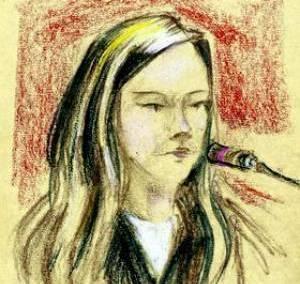The media's 'right' to photograph a witness

The point of justice being administrated in public is not to indulge fascination with lurid details of certain trials. Jean Treacy is an exemplary citizen. She gave evidence, which must have been deeply embarrassing and humiliating for her, against her former lover who was accused of murdering his wife. She could have been uncooperative with gardaí when they interviewed her once they discovered she had had an affair with the then suspect, Eamonn Lillis. She could have failed to remember as many contrive to do in court cases and at tribunals. She could have told them nothing relevant to a case against Eamonn Lillis, thereby avoiding having to give evidence and at least the brunt of inevitable publicity.
(Picture: a court drawing of Jean Treacy)
Instead, she co-operated with gardaí; she told them of what Eamonn Lillis had told her about the row with his wife, Celine Cawley, and how he had then claimed the wife had died. When months later he sent her a present of jewellery she went immediately to gardaí.
Of course there probably was an element of self-interest in this for her. She must have been frightened about being drawn into the whole sordid business surrounding the death of Celine Cawley. She might have thought even that she would be charged with an offence herself. But the likelihood also is that she co-operated with the investigation into the death of Celine Cawley beyond what she needed to do and beyond what she was frightened into doing.
The acknowledgement in her evidence that it was she who instigated the affair with Eamonn Lillis must have been deeply embarrassing for her, especially as she was engaged to be married to someone else at that time. And it is hardly surprising, therefore, that she would have asked gardaí to give her some protection against the hordes of photo journalists that, inevitably, would be surrounding the entrance to the court on the day she was due to give evidence. It was decent of gardaí to comply with such a request and, one would hope, they would do the same for any other prosecution or defence witness in similar circumstances, although that is certainly to be doubted.
The claim there was a “right” on the part of the media to have this witness parade in front of them on her way to and from the court is palpable nonsense. There is a constitutional requirement that justice “be administrated in public” but there is a heavy qualification preceding that requirement: “save in such special and limited cases as may be prescribed by law”. And the law does prescribe numerous instances where justice is not administrated in public, such as family law cases, company law cases, tax law cases. The law also curtails what may be made public in relation to other cases, such as cases involving children.
It is also obvious from case law on this that the requirement that justice be administered in public does not mean that justice should be administered in Croke Park where as many people as possible could attend. Or that trials be televised. Or that witnesses must be available to be photographed going to and from the court. In one authoritative judgment (Re R Ltd, a 1990 case) it was stated: “The actual presence of the public is never necessary but the administration of justice in public does require that the doors of the courts must be open so that members of the general public may come and see for themselves that justice is done.”
Another judgment (Irish Times Ltd v Ireland, a 1998 case) states: “Justice is best served in an open court where the judicial process can be scrutinised.”
And in that same case in another judgment it was stated in support of justice being administered in public: “The most benign climate for the growth of corruption and abuse of power whether in the judiciary or members of the legal profession, is one of secrecy.”
The European Court of Human Rights in another case (Sutter v Switzerland) held: “The public character of proceedings before the judicial bodies . . . protects litigants against the administration of justice in secret . . . it is also one of the means whereby confidence in the courts can be maintained.”
Nothing in any of this gives any ground for the contention that the media has a “right” to photograph witnesses, especially in circumstances in which witnesses are giving evidence of a deeply embarrassing character to themselves, but giving it nonetheless as conscientious citizens. The point of justice being administrated in public is not to indulge public fascination with the lurid details of particular trials; it is to permit scrutiny of the judicial process, so that any corruption or malfunctioning of the judicial system can be subject to public scrutiny.
It is therefore odious that Jean Treacy and her extended family should now be hounded by sections of the media, seeking to gain competitive advantage and corporate profit and, for the journalists involved, perverse career enhancement and personal recognition. Instead of winning the gratitude of her fellow citizens, for her public-spirited contribution to the judicial process, she is to be hunted down and subjected to further humiliation. And meanwhile the law remains mute and the upholders of the law listless in the face of this manifest injustice.
Wasn’t there to be a new law on privacy?
